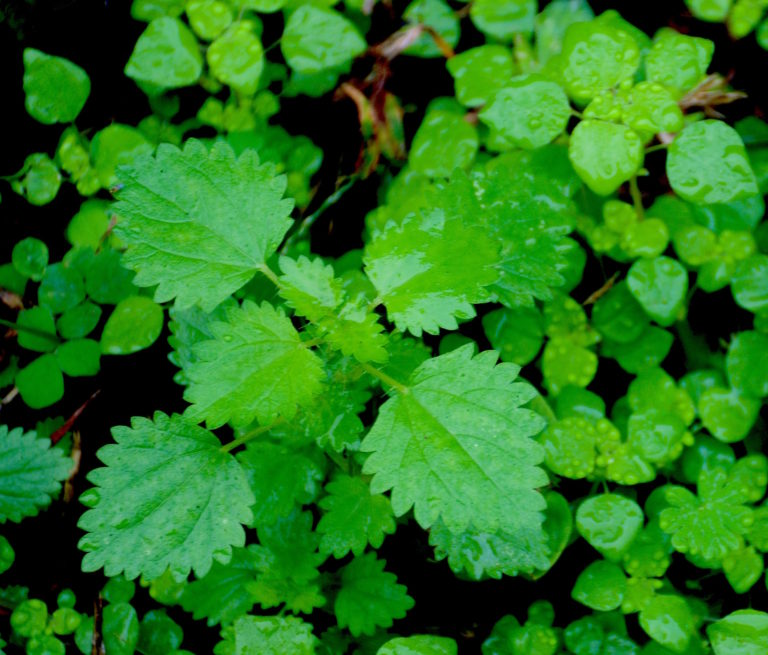
Stinging Nettles are making their seasonal debut. Photo by Green Deane
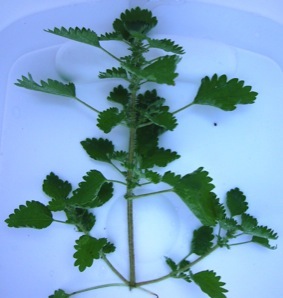
The entire plant is covered with stingers. Photo by Green Deane
Our mighty stinging nettles are up. They’re one of the most popular wild edibles.The most powerful stinging nettle is in New Zealand (Urtica ferox) which kills animals and has claimed at least one human life. Our nettle, Urtica chamaedryoides, has a sting like a giant wasp and can burn for days or more. While its common name is a deceptive, “Heartleaf Nettle” its botanical gets to the point, “Stinging Dwarf.” Quite edible but you must handle it with care. If this particular species stings me it is not only extremely painful but a welt develops and the site is sensitive to temperature changes and any liquid for more than a week. The irritant compounds are histamines and acetocholines. Apparently I am quite sensitive to them though I can eat the plant raw or cooked (crushing the needles disarms them.) Also don’t confuse this plant with another stinging plant called the Spurge Nettle, Cnidoscolus stimulosus (video here ). That has an edible root but the leaves are usually not eaten. To learn more about the Heartleaf Nettle go here. For a video, here.
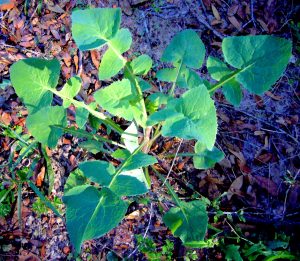
Common Sow Thistle. Photo by Green Deane
Another not unexpected seasonal green this weekend was the sighting of Sow Thistles in Port Orange. Like its relative the Dandelion it, too, prefers the cooler months locally. Not a true thistle it’s one of the more milder seasonal greens. Although Sow Thistles are commonly called “thistles” they are not in the genus and do not draw blood like true thistles. True thistles are well-armed with needle-sharp spines. While the Sow Thistle can look intimidating it’s mostly just show in that the spines are soft. There are two species locally, the Common Sow Thistle and the Spiny Sow Thistle. The latter is a bit rougher than the former but no where near as abusive as true thistles. Both are slightly bitter raw. A few minutes of boiling or steaming takes away the bitterness completely (unlike wild lettuce which always stays slightly bitter.) I have a video on the sow thistles and to read more about them go here.

Classes are held rain or shine or cold. (Hurricanes are an exception.) Photo by Kelly Fagan.
Temperatures are moderating this week for warmer foraging classes this weekend. I’m mid-state Saturday, just east of Orlando, and then in Sarasota Sunday.
Saturday, January 23th, Blanchard Park, 10501 Jay Blanchard Trail, Orlando, FL 32817. 9 a.m. to noon, meet at the pavilion by the tennis courts.
Sunday, January 24th, Red Bug Slough Preserve, 5200 Beneva Road, Sarasota, FL, 34233. 9 a.m. to noon.
Saturday January 30th, Wickham Park: 2500 Parkway Drive, Melbourne, FL, 9 a.m. to noon. Meet at the dog park.
Sunday January 31st, Bayshore Live Oak Park, Bayshore Drive. Port Charlotte. 9 a.m. to noon, meet in the parking lot at Ganyard and Bayshore.
Saturday February 6th, Boulware Springs Park, 3420 SE 15th St., Gainesville, FL 32641. 9 a.m. to noon, meet at the pavilion by the pump house.
Sunday, February 7th, Mead Gardens, 1500 S. Denning Dr., Winter Park, FL 32789. 9 a.m. to noon. The entrance is on the west side off Denning not the east side off Pennsylvania. Some GPS maps are wrong. Meet near the bathrooms.
For more information, to pre-pay or sign up go here.
A reminder this is Chickweed season though perhaps it’s a bit late this year which is odd in that we have been unseasonably cold. Among the wild edibles Chickweed is fairly easy to identify with several distinct characteristics. Chickweed has a line of hair on the stem that switches sides at every node (where there are two leaves.) It also has a stretchy inner core and tastes like raw corn. Add the time of year here — our winter — and it’s an easy-to-identify foragable. To read more about chickweed go here. I have a video about it here.
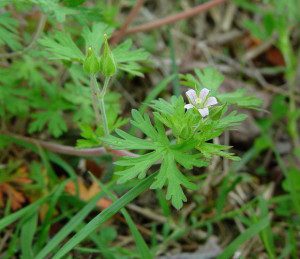
Wild Geraniums are showing up on lawns.
Also found in lawns this time of year are wild geraniums, usually Cranesbill or Stork’s Bill. (Why one is one word and the other two-words possessive I do not know.) Botanically they are Geranium carolinianum and Erodium circutarium. Neither is great foraging. In fact both are more medicinal than edible but they seem to get mention in a variety of foraging books. The problem is they are extremely bitter. You might be able to toss a little bit of both in a salad but that’s about the extent of it. If you have what you think is a Cranesbill or a Stork’s Bill but it has more of a bottle brush blossom than five petals you might have the non-edible Fumaria. It comes up this time of year and from a distance the leaves can remind one of the wild geraniums. To read more about them go here.
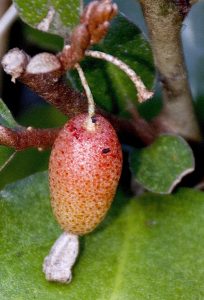
Silverthorn berries ripen in Feburary.
Another seasonal species to be looking for is Silverthorn one of the few fruits that sets in our winter and is usually ripe about Valentine’s Day. That’s handy because the jelly-bean sized fruit is red with a gold netting or spray on it. But, if you remember the red fruit is ready around Valentine’s Day you’ll be looking for it. The boxy blossoms help you identify which shrubs will be producing fruit this year. It’s a common landscape plant and also an escapee. New fruit likes to grow on new growth and with waxy leave the species is fairly easy to identify. Even though the fruit is small it has the distinction of having the highest amount of the antioxidant lycopene per weight of any fruit. You can read about Silverthorn here and watch a video here.

Green Deane videos are now available on a USB.
150-video USB or 135 video DVD set would be a good winter present and either is now $99. My nine-DVD set of 135 videos has been selling for seven years and are still available. They are the same videos I have on You Tube. Some people like to have a separate copy. A second option is a16-gig USB that has those 135 videos plus 15 more. While the videos can be run from the DVDs the videos on the USB have to be copied to your computer to play. They are MP4 files. The150-video USB is $99 and the 135-video DVD set is now $99. The DVDs will be sold until they run out then will be exclusively replaced by the USB. This is a change I’ve been trying to make for several years. So if you have been wanting the 135-video DVD set order it now as the price is reduced and the supply limited. Or you can order the USB. My headache is getting my WordPress Order page changed to reflect these changes. We’ve been working on it for several months. However, if you want to order now either the USB or the DVD set make a $99 “donation” using the link at the bottom of this page or here. That order form provides me with your address, the amount — $99 — tells me it is not a donation and in the note say if you want the DVD set or the USB.

Green Deane Forum
Want to identify a plant? Perhaps you’re looking for a foraging reference? You might have a UFO, an Unidentified Flowering Object, you want identified. On the Green Deane Forum we — including Green Deane and others from around the world — chat about foraging all year. And it’s not just about warm-weather plants or just North American flora. Many nations share common weeds so there’s a lot to talk. There’s also more than weeds. The reference section has information for foraging around the world. There are also articles on food preservation, and forgotten skills from making bows to fermenting food.
This is weekly newsletter #441. If you want to subscribe to this free newsletter you can find the sign-up form in the menu at the top of the page.
To donate to the Green Deane Newsletter click here.


A new book published in New Zealand by NZ pathologist Cynric Temple-Camp, The Quick and the Dead, describes the mysterious death of Jason Chase due to encountering Ongaonga (Urtica ferox). The review is in the Herald on Sunday, July 12, 2020. i’m waiting to read the book.
The poison contained in the plant is called ‘Triffidin’
I grow the Brish species Urtica dioica, for tea, food, beer, and because it’s the host plant of the Yellow Admiral butterfly.